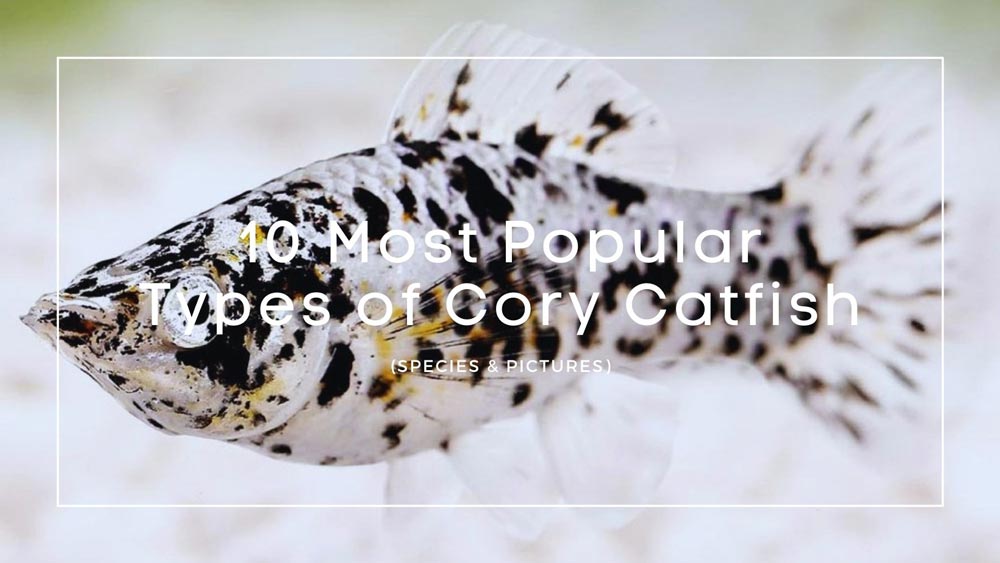A staple and widely popular fish in the aquarium world – Cory Catfish is the active day dweller that will make your fish tank lively.
Unlike the bottom-dwelling aquarium fish that prefer hiding the entire day, Corys chase each other around while scanning their surroundings. Then again, they thrive even when held in captivity, making the most out of the water conditions.
And with the right kind of food, you’ll see your home aquarium flourishing within no time. But for that, you’ll need to know about the different types of cory catfish – easily found in pet stores.
So, without further delays, let’s dive in!
Panda Cory (Panda Catfish)

The pale white body with prominent black markings resembling that of a panda is why this catfish is widely known as – the Panda Cory. Native to the Peruvian Amazon, these fish prefer warmer conditions ranging somewhere between 75 and 85 degrees Fahrenheit.
Temperatures below this range will only make them lethargic. Of course, it will also increase the risks of ich, body fungus, and fin rot. Besides temperature, check your tank water chemistry – acidic to neutral water with a pH level of 6.0-7.0 should be ideal.
It’s also important to keep in mind that Panda Corys are social, so raising a single fish may make it feel exposed. Instead, place them with other Corydoras of the same kind.
| Scientific Name: | Corydoras panda |
| Family: | Callichthyidae |
| Origin: | Asia, Captive-Bred |
| Care Level: | Easy |
| Color Form: | Black, Yellow |
| Size: | 2½” |
| Temperature: | 72-79° F |
| PH: | 5.8-7.0 |
| Diet: | Omnivore |
| Minimum Tank Size: | 30 gallons |
| Temperament: | Peaceful |
| Compatibility: | Mixed |
Pygmy Cory Catfish
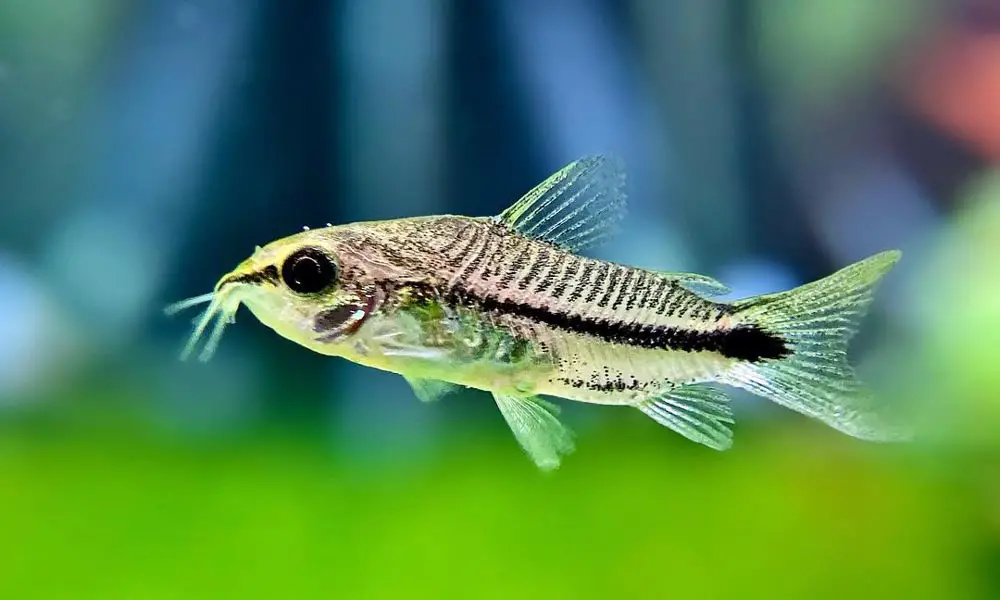
As one of the smallest catfish species, Pygmy Corys make themselves at home even in 5 to 10-gallon tanks. Just make sure you provide them with companions as they tend to form shoals and swim around, even if it’s in the midwater.
You’ll be able to tell the adults apart by simply looking at them as they are sexually dimorphic. While the females are visibly plumper, reaching up to 1 inch in length, the males grow only up to 3/4th of an inch.
That said, they are a peaceful species of fish that get easily intimidated by larger aggressive fish like Cichlids and Barbs. So, as far as it goes for tank mates, keep them with other nano fish like the Pea Pufferfish and Chili Rasboras.
| Scientific Name: | Corydoras pygmaeus |
| Family: | Callichthyidae |
| Origin: | Tank-raised, but indigenous to India |
| Care Level: | Easy |
| Color Form: | Silver |
| Size: | Up to 1″ |
| Temperature: | 72° – 79° F |
| PH: | 6.4 – 7.4 |
| Diet: | Omnivore |
| Minimum Tank Size: | 10 gallons |
| Temperament: | Peaceful |
| Compatibility: | Small peaceful community |
False Julii Cory Cat
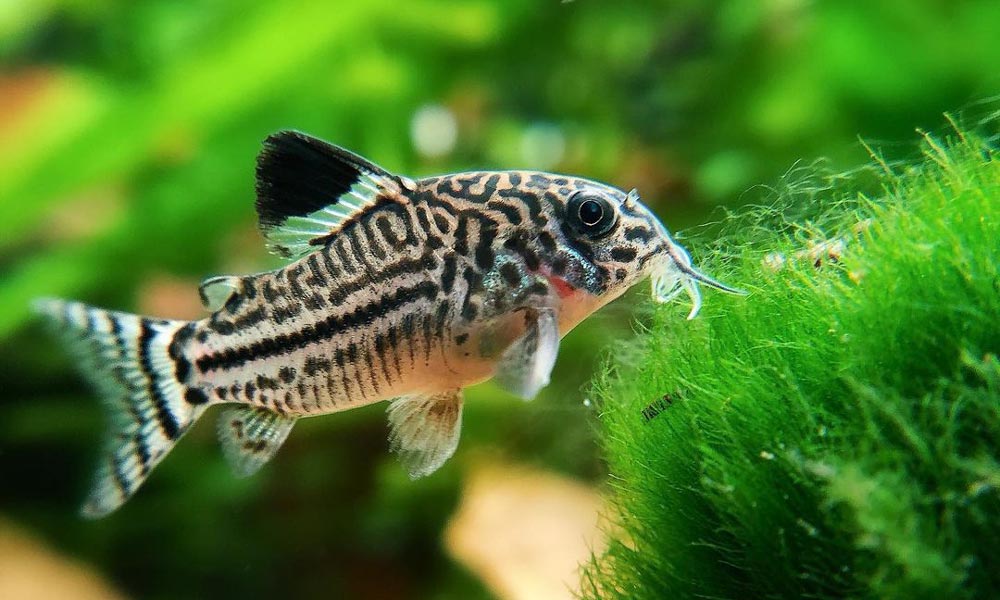
Most commonly found in pet stores, the Julii Cory is a hardy, small, and uniquely patterned fish for beginner aquarists. It rarely grows larger than 2 inches, so you may easily keep a small group in a 10 to 15-gallon tank. However, a 20 to 30-gallon tank is more practical for keeping 6 to 12 of them together.
Just don’t confuse it with the False Julii Cory or Corydoras trilineatus – you can tell them apart by their “almost” similar patterns. The actual Julii Cory comes with distinct spots on its head and flanks.
| Scientific Name: | Corydoras julii |
| Family: | Callichthyidae |
| Origin: | Farm Raised, USA |
| Care Level: | Easy |
| Color Form: | Black, White |
| Size: | 2″ |
| Temperature: | 72-79° F |
| PH: | 5.8-7.0 |
| Diet: | Omnivore |
| Minimum Tank Size: | 30 gallons |
| Temperament: | Peaceful |
| Compatibility: | Small peaceful community |
Peppered Cory Cat

Native to the eastern parts of South America, the Peppered Cory is another catfish species suitable for beginners.
They grow up to 2 1/2 inches in length, and when kept under bright yet stressful conditions, they are typically cream and grey in color. But what makes them stand out is their faint green textured body that may seem like a glow under subdued lighting.
Moving on to their nature, Peppered Corydoras are peaceful and breed easily in alkaline waters. In fact, they adapt well even in captive conditions, provided they are fed live and frozen foods in regular intervals.
| Scientific Name: | Corydoras paleatus |
| Family: | Callichthyidae |
| Origin: | South America |
| Care Level: | Easy |
| Color Form: | Black, Green, White |
| Size: | 2½” |
| Temperature: | 72-79° F |
| PH: | 5.8-7.0 |
| Diet: | Omnivore |
| Minimum Tank Size: | 10 gallons |
| Temperament: | Peaceful |
| Compatibility: | Mixed |
Bronze Corydoras

Bronze Cory is widely found throughout South America, but there is a mystery surrounding its origin. That said, the first species was discovered in Trinidad, and it’s from there that the Corydoras aeneus gets its name.
These Corys are hardy and feed on all kinds of prepared, live, and frozen food, making them easy to care for. And if you want your fish to spawn, feed them small invertebrates, including tubifex, brine shrimp, and blood worms. You could also provide them with micro pellets, flakes, and other types of fish food.
| Scientific Name: | Corydoras aeneus |
| Family: | Callichthyidae |
| Origin: | Argentina, Colombia, Venezuela |
| Care Level: | Easy |
| Color Form: | Black, Green, White |
| Size: | 2½” |
| Temperature: | 72-79° F |
| PH: | 5.8-7.0 |
| Diet: | Omnivore |
| Minimum Tank Size: | 10 gallons |
| Temperament: | Peaceful |
| Compatibility: | Mixed |
Albino Aeneus Cory Cat
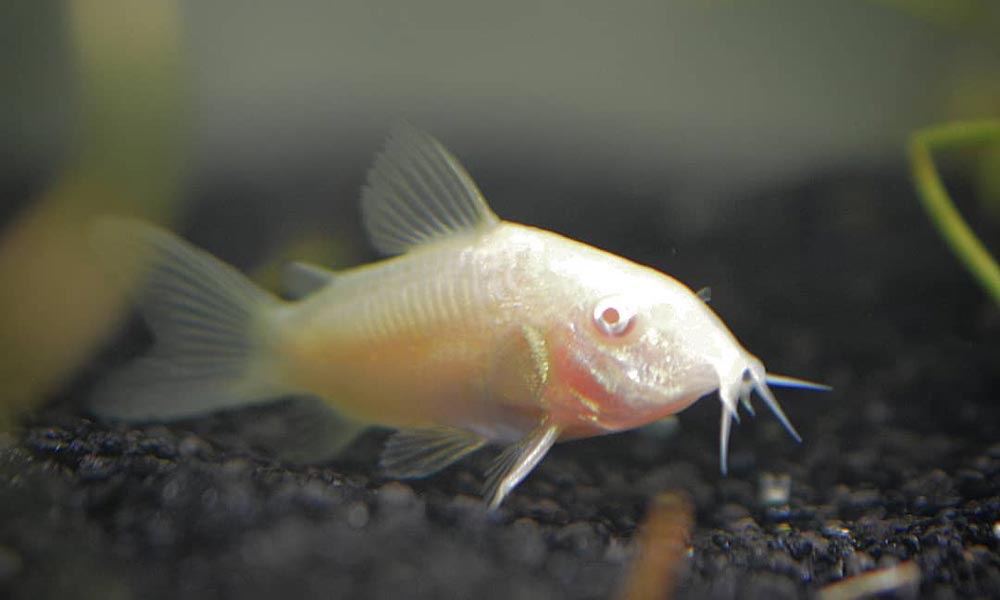
You’ll find the Albino Cory Catfish in the tributaries of the Amazon river – easily identifiable because of its pink or white color pattern with multiple barbels around its mouth. Now, when it comes to breeding this fish species, you’ll need to keep them in a spacious 30-gallon tank having slightly acidic water with pH levels between 6.0 and 7.2.
It’s also important to maintain the water temperature between the range of 72 and 79 degrees Fahrenheit. However, a sudden 20% decrease in temperature can help them spawn faster.
| Scientific Name: | Corydoras aeneus |
| Family: | Callichthyidae |
| Origin: | South America |
| Care Level: | Easy |
| Color Form: | Red, White |
| Size: | 2½” |
| Temperature: | 72-79° F |
| PH: | 6.0-7.2 |
| Diet: | Omnivore |
| Minimum Tank Size: | 30 gallons |
| Temperament: | Peaceful |
| Compatibility: | Mixed |
Skunk Cory Cat
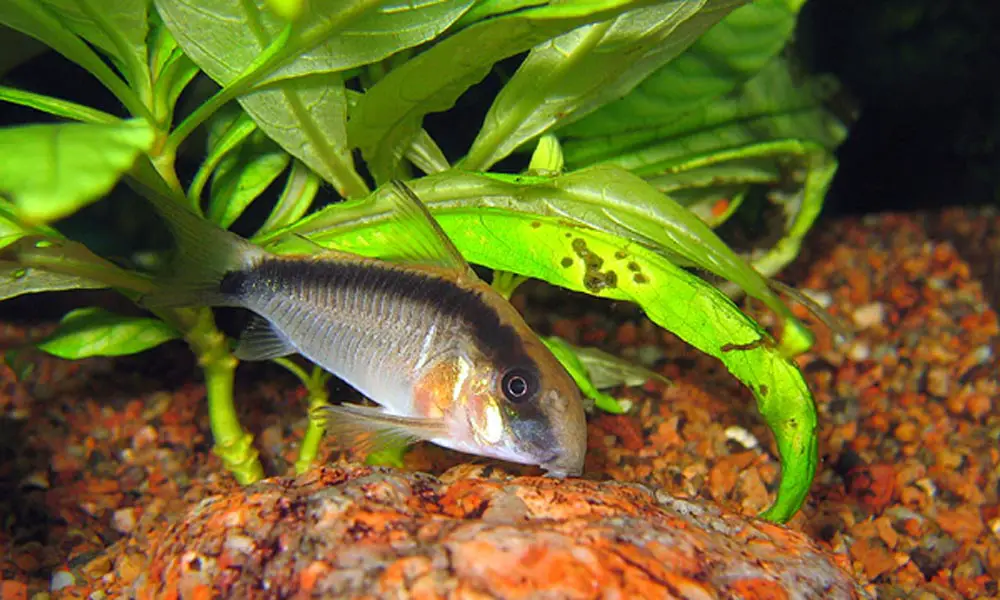
Yet another easily identifiable species – the Skunk Cory Catfish have a squashed, short nose with broad cream or pink flanks and dark stripes along their backs. But what makes the fish stand out is its metallic golden hues on its gill covers.
Now, breeding this catfish is a bit challenging; however, it’s not impossible, provided you maintain the temperature of the soft, acidic tank water between 78 and 84 degrees Fahrenheit. Also, give them a lot of frozen and live food.
| Scientific Name: | Corydoras arcuatus |
| Family: | Callichthyidae |
| Origin: | Brazil |
| Care Level: | Moderate |
| Color Form: | Black, White |
| Size: | 2½” |
| Temperature: | 68-77° F |
| PH: | 6.2-7.2 |
| Diet: | Omnivore |
| Minimum Tank Size: | 20 gallons |
| Temperament: | Peaceful |
| Compatibility: | Mixed |
Emerald Green Cory Cat
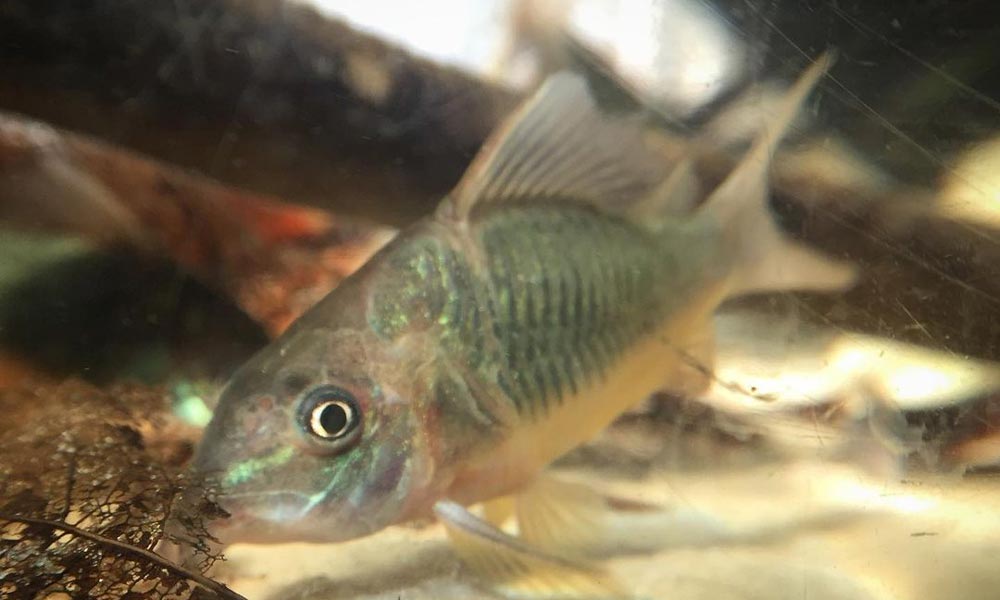
The chunky body, elongated nose, and spectacular coloration make the Emerald Cory among the most desirable kinds of catfish. In fact, this is one of the biggest Corydoras that grow up to 4 inches.
As such, a 30-gallon tank will be needed to help them move around comfortably. Coming to the ideal aquarium conditions, Emerald Corys prefer neutral to acidic water, but they can also easily adapt to varying chemistries, provided the temperatures remain within the range of 78 to 86 degrees Fahrenheit.
| Scientific Name: | Brochis splendens |
| Family: | Callichthyidae |
| Origin: | South America |
| Care Level: | Easy |
| Color Form: | Clear, Green, White |
| Size: | 3½” |
| Temperature: | 72-79° F |
| PH: | 6.8-7.2 |
| Diet: | Omnivore |
| Minimum Tank Size: | 30 gallons |
| Temperament: | Peaceful |
| Compatibility: | Mixed |
Sterba’s Corydoras
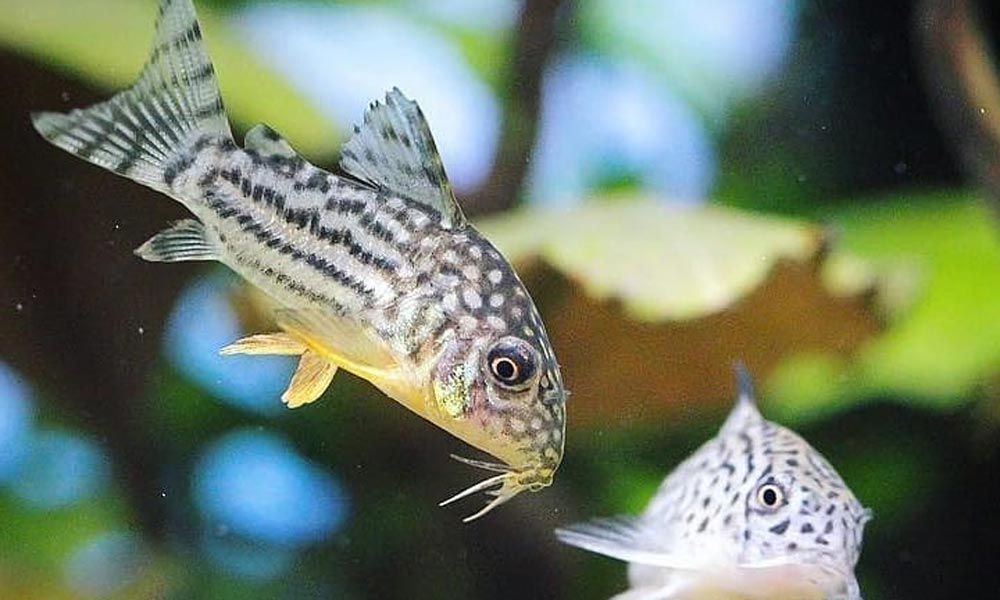
The bright pectoral spines and delicate reticulate patterns make it easier to identify the Corydoras sterbai. Earlier, they were expensive, but today, aquarists can get them from a pet store without burning a hole in their pockets.
Now, the original specimens of this catfish were sensitive to ammonia and nitrates. That’s why it’s better to breed tank-raised fish as they are hardier and more than willing to spawn in less than ideal conditions. They will grow up to 2 ½ inches even in alkaline water, but acidic, soft water conditions ensure better breeding responses.
| Scientific Name: | Corydoras sterbai |
| Family: | Callichthyidae |
| Origin: | Brazil, South America, Upper Rio Guapore |
| Care Level: | Easy |
| Color Form: | Black, Tan, Yellow |
| Size: | 3″ |
| Temperature: | 70-77° F |
| PH: | 6.2-7.8 |
| Diet: | Omnivore |
| Minimum Tank Size: | 30 gallons |
| Temperament: | Peaceful |
| Compatibility: | Mixed |
Leopard Cory Catfish
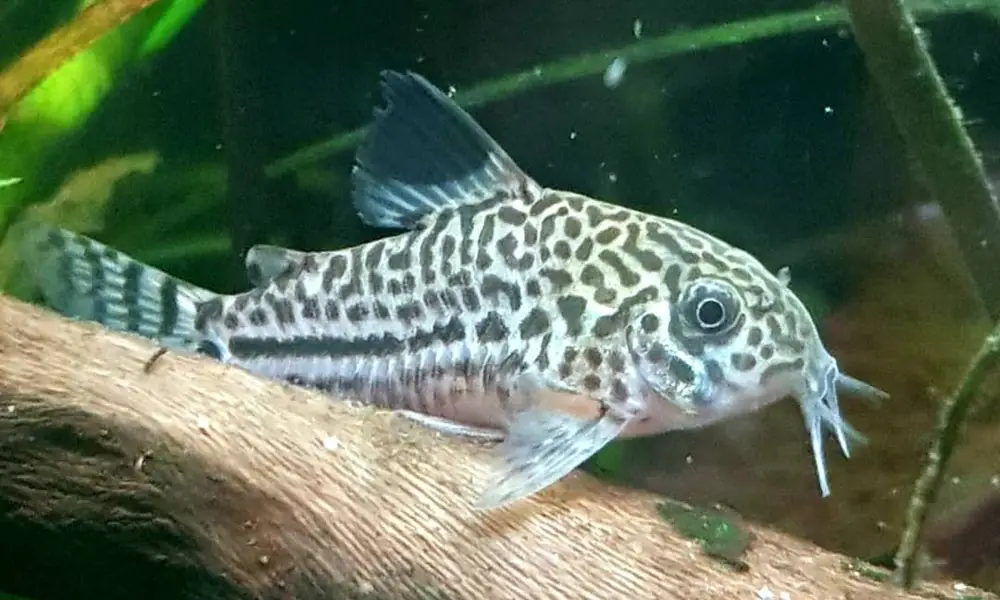
Most commonly known as the Three Stripe Corydoras, the Leopard Cory Catfish is a peaceful fish species that can grow for 2 to 3 years. It’s characterized by its pale grey silvery color and narrow dark stripes almost resembling a leopard. That’s one of the reasons why it’s so popular in the aquarium community.
In fact, breeding this fish species is easy – all you have to do is feed them well with tablets and sinking pellets. The diet should also be supplemented by freeze-dried and live fish food like worms.
| Scientific Name: | Corydoras julii, Synonym Corydoras leopardus |
| Family: | Callichthyidae |
| Origin: | South America: Central Amazon River basin |
| Care Level: | Easy |
| Color Form: | Silvery Gray |
| Size: | 2½” |
| Temperature: | 72-79° F |
| PH: | 6.5-7.8 |
| Diet: | Omnivore |
| Minimum Tank Size: | 10 gallons |
| Temperament: | Peaceful |
| Compatibility: | Mixed |
FAQs:
Can You Mix Different Types Of Cory Fish?
Ideally, Corydoras are peaceful and social types of catfish that prefer their own kind. But it’s possible to mix different types of Cory fish in a big aquarium – just get three to six of each species, be it Panda, Sterbai, Albino, or Peppered Cory fish.
How Many Corys Should I Keep In One Tank?
You can keep up to eight Cory Catfish in a small or average-sized fish tank. Start by adding one fish per gallon; refrain from adding multiple fish at the same time in a new aquarium.
A larger fish tank of over 30 gallons will be sufficient for breeding more than 12 Corys. Just keep in mind that they should be kept in groups of 5 or 6.
What Types Of Cory Catfish Do Well In Hard Water?
Cory Catfish can survive in hard water provided you maintain the ideal temperature conditions and pH levels (6.0 to 8.0). Most commonly, Bronze Corys remain quite active despite the hard water parameters. However, they fail to thrive compared to soft water conditions.
Is It Possible For Two Different Types Of Cory Catfish To Mate?
Yes, two different types of Cory Catfish can mate. That’s why it’s important to make a careful choice while keeping a variety of Corys together for interbreeding.
Summary
That brings us to the end of our list, and it’s time for us to bid you farewell.
But before that, we’d like to leave you with a few pro tips. Now, as popular and desirable aquarium fish with a peaceful temperament, most types of Corys are easy to breed. In fact, you can keep more than one kind of this catfish in your aquarium and breed them in groups.
Just make sure you refrain from having Barbs and Cichlids as their tankmates. It’s better to keep Angelfish, Mollies, Fancy Guppies, Gouramis, and Platies instead. Also, pay attention to their diet – in addition to sinking pellets and tablets, provide them with live and frozen foods to grow well.
That’s all there is to know about the different types of Cory Catfish. We’ll be back soon with more informative guides on other freshwater fish types. Till then, take care.
